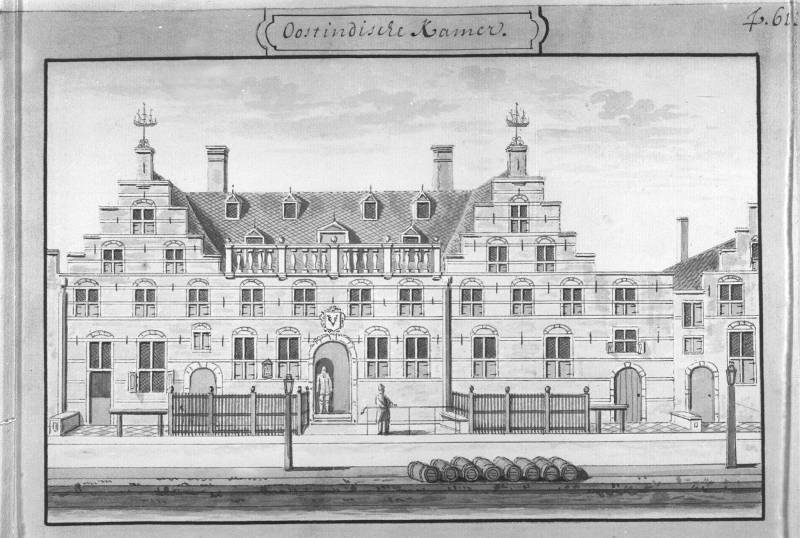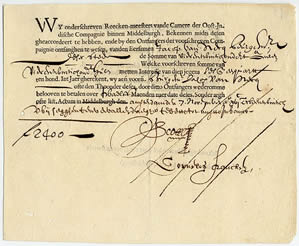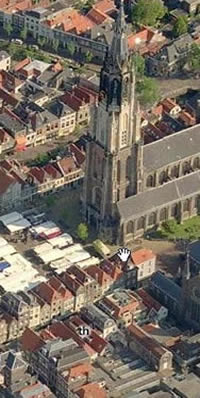Most of the text below is derived from:
Jörg, Christian J. A. "The Dutch Connection: Asian Export Art in the Seventeenth and Eighteenth Centuries." The Magazine Antiques, March 1, 1998.
Anyone who has had the pleasure of taking a walk in Delft and is familiar with the places related to the life and art of Vermeer is amazed by their close proximity. The Flying Fox, where Vermeer was born, is barely 50 steps from Mechelen, the inn which his father would later purchase when the future artist was just nine years old. From Mechelen it was only a few scant yards to the front door of the Guild of Saint Luke, the fulcrum of Vermeer's professional interests. The artist's later living-quarters (proffered by his generous his mother-in-law Maria Thins) and studio (where he painted many of his masterworks) is just across the Delft Markt (Market Place) on Oude Langendijk, little more than 100 paces away.
The longest distance by far, a brisk 10 minutes walk, is from the center of Delft to the Kolk, where Vermeer composed and painted the famous View of Delft. The near minuscule dimensions center of Delft should not deceive us. The city had considerable political, moral and economic importance in the Netherlands and was physically connected to the outer world through its canals and through its affiliation with the Vereenigde Oost-Indische Compagnie (VOC), the Dutch East India Company. If Vermeer did not, as it seems, venture more than occasionally outside his beloved home town, the farthest fetches of the world came directly to his feet.
Kamer Delft
The Delft chamber (Kamer Delft) of the VOC played a role in the trade operations of the company, although it was not as prominent as the chambers in cities like Amsterdam and Zeeland, which were more significant in terms of their size and the volume of trade they handled. The chamber in Delft was one of the smaller chambers of the VOC, alongside those in cities like Hoorn and Enkhuizen. "The Delft chamber had limited maritime beginnings and only became involved in expeditions to Asia around the time the company was founded. Delft citizens invested 469,400 guilders into the VOC. The Oostindisch Huis on Oude Delft, acquired in 1631, became the central building for the chamber after renovations, with a significant meeting room dating from 1722 that still stands.
"The shipyard and shipping activities were based in Delfshaven (now part of Rotterdam), where the VOC built and expanded their facilities starting in 1671, including the Zeemagazijn warehouse. From 1602 to 1794, about 111 ships were launched from the Delfshaven shipyard."Gerrit Knaap, "Kamers van VOC," VOC Kenniscentrum, accessed November 4, 2023. Despite its smaller size, the Delft chamber contributed to the overall operations of the VOC, which included trade in a wide range of goods such as spices, silk, cotton, porcelain, and other fine goods. Delft itself was known for its pottery industry, particularly Delftware, which was inspired by and a response to the import of Chinese Kraak by the VOC. There was a synergy between the trade of the VOC and the local industries that were influenced by the goods and knowledge brought back by the company's ships.
The Delft chamber would have been responsible for outfitting ships, hiring crews, and managing part of the VOC's fleet. Like other chambers, it would have shared in the profits of the VOC’s trade and would have had its own warehouses, administrative buildings, and shipyards, though on a smaller scale compared to the larger chambers.
The following summary is based on Christina An's and Menno Fitski's detailed analysis of Dutch and Japanese porcelain trade, as discussed in " Vermeer’s Jar." The Rijksmuseum Bulletin 71 (2):100-107.
In 1661, the VOC sent models ofLocally produced Delftware to Japan to serve as examples for Japanese artisans to replicate. By November 1662, these Japanese craftsmen had already produced porcelain pieces modeled after the Delftware, which were then shipped back to the Netherlands by 1663.
These Delftware models shared design similarities with the Japanese Kraak, such as the jar shape and decorative motifs. Yet, two main differences suggest that Vermeer's depicted jar in his paintings was based on the Japanese porcelain rather than a Delftware original. Firstly, the Japanese porcelain was glossier, an effect Vermeer captured with pronounced highlights. Secondly, the physical characteristics of the jar's neck and lid were more closely aligned with the Japanese style.
The relationship between Delftware and Japanese porcelain is complex. Documentation suggests Delftware was indeed replicated in Japan. However, stylistically, Japanese porcelain owed more to Chinese influences, particularly in landscape and figure depictions. This somewhat undermines the idea that Delftware was the original model for Japanese porcelain. Additionally, while Delftware may have been more detailed, it's possible that it could have been an elaboration on a simpler Japanese original.
The inclusion of Delftware in paintings of the era, such as one by Cornelis De Man, helps to date these artworks more precisely. De Man's work shows a keen representation of a Delftware jar, contrasting with Vermeer's more obscure portrayal of the Japanese jar. This obscurity is noted as a common trait in Vermeer's works, adding to the enigmatic quality of his paintings.
The VOC
The VOC was established in 1602 and quickly became a powerful symbol of the Dutch Golden Age. As a pioneering joint-stock company, the VOC was granted a monopoly over trade in Asia by the Dutch government, specifically focusing on the lucrative spice trade. Its formation marked a turning point in global commerce and can be seen as a precursor to modern corporations.
The VOC had the authority to wage war, imprison and execute convicts, negotiate treaties, strike its own coins, and establish colonies. Equipped with these quasi-governmental powers, the company set out to dominate trade routes in the Indian Ocean and established a network of trading posts and settlements throughout Asia, including in present-day Indonesia, India, Sri Lanka, and Malaysia.
The strategic establishment of these trading posts allowed the VOC to control the spice trade, particularly in nutmeg, cloves, and pepper. They created a trade empire that connected the East to the West, funneling goods and wealth into the Netherlands and contributing significantly to the country's economic prosperity during the seventeenth century.
The VOC was also known for its military prowess and was heavily involved in the colonial subjugation of local populations, with a history marked by exploitation, violence, and the displacement of indigenous peoples. The company employed a large fleet of merchant marine vessels and had a sizeable private army to protect its interests and maintain its grip on the trade.
In its heyday, the VOC was one of the largest trading companies in the world with thousands of employees, a fleet that surpassed that of many nations, and financial power that enabled it to exert a significant degree of influence over international affairs. However, by the 18th century, corruption, internal inefficiencies, and the rise of competitive trade from other European nations led to its decline.
The company went bankrupt and was officially dissolved in 1799, but its impact on global trade and the history of corporate governance had already been cemented. The VOC's legacy is complex, characterized by both its pioneering business model and its role in the darker aspects of colonial exploitation.

The logo of the VOC consisted of a large capital "V"' with an "O" on the left and a "C" on the right leg (fig. 1). The first letter of the hometown of the chamber conducting the operation was placed on top. The flag of the company was orange, white, blue with the company logo embroidered on it.
Delft was one of six towns in Holland that had a chamber of the VOC. Delft accessed the world's oceans through Delfshaven, the harbor town that in the seventeenth century was part of the municipality, on the right bank of river Nieuwe Maas, in South Holland. Since Delft was not located on a major river, in 1389 a harbor was created about 10 km (6 mi) due south of the city, to be able to receive seafaring vessels and avoid tolls being levied by the neighboring and competing city of Rotterdam.
In Delfshaven, the VOC maintained a shipyard, although the central oversight was from their main office in Delft. In 1631 two houses were bought on Oude Delft, renovated and turned into the Oost-Indisch Huis (East India House) (fig. 2). Goods from the Dutch colonies were sold rapidly in Delft's market, and the local elite profited from having first pick of these goods. The VOC's Delft chamber created well-paid jobs and assigned favored individuals to various roles. Indirectly, the VOC boosted Delft's economy by employing local suppliers and labor to process and transport goods to other European countries. Additionally, the company provided employment opportunities for the poor, including orphaned boys, on their ships and in Asia. By the end of the seventeenth century, the VOC became the sole economic stabilizer in Delft's declining economy.

Anonymous
First quarter of the 18th cenulrv.
Watercolor, 17.9 x 27.2 cm.
Gemeentearchief, Delft

One of the most fascinating aspects of the VOC's trade with the East was its influence on decorative arts produced in the West. Ceramics, lacquer, textiles and souvenirs from China, Japan and India were much sought after in the Netherlands, where they were used to ornament interiors and as sources for imitation and inspiration for new designs. One of the most unique consequences of the involvement with the VOC was the direct importation of Chinese porcelain. Mainly blue-and-white, this porcelain was an enormous hit with the people of Holland. Complete shiploads were readily purchased by wealthy Dutchmen s However, due to internal troubles in China around 1645, the import of Chinese porcelain stagnated. Via its trading post on Deshima, the artificial island in the bay of Nagasaki, Japan, the VOC was able to get only a limited supply of Chinese porcelain.
The Chinese potters developed Kraak porcelain in the second half of the sixteenth century and sold it throughout Southeast Asia. When the Dutch came to trade, they bought and shipped back thousands of pieces of this porcelain for resale at an excellent profit. For the burgher class this porcelain demonstrated their new status and wealth. It was exotic, rare, sturdy, finely decorated, and easy to clean.
The situation triggered a fascinating development in the Netherlands. Since the 1620s earthenware producers in Delft, Haarlem and probably Rotterdam had been trying to make high quality imitations of Chinese porcelain. However, it was only after a prolonged period of experimentation that they succeeded in making thin, light, white-glazed earthenware decorated in blue in the Chinese style. Delft became the center of the industry since its former beer breweries could accommodate the large and sprawling potteries. Another immensely popular product of the Delft pottery industry were the small floor tiles which can be seen in a number of Vermeer paintings. These tiles protected the walls from the daily assault of brooms and mops. They covered the walls of particularly humid environments such as cellars as well as the interiors of the Dutch kitchens' hearths. The number of factories in Delft grew from four in 1647 to more than twenty in 1661 and offset the steep decline in the local beer industry.

A row of common Delft tiles which illustrate children at play.
